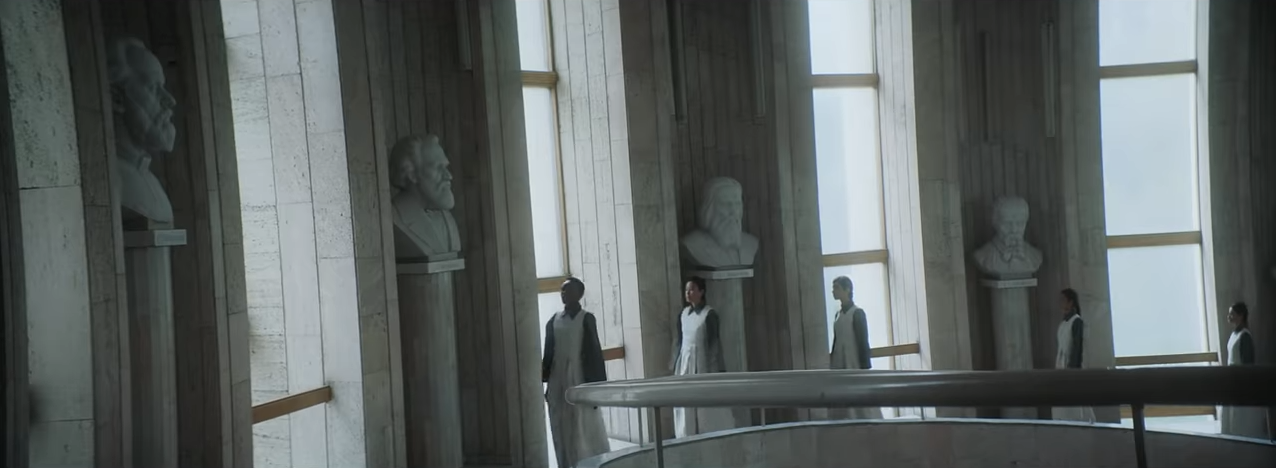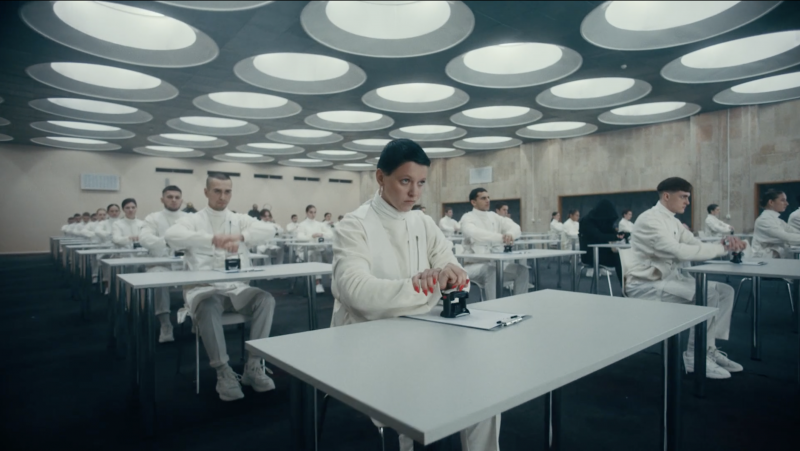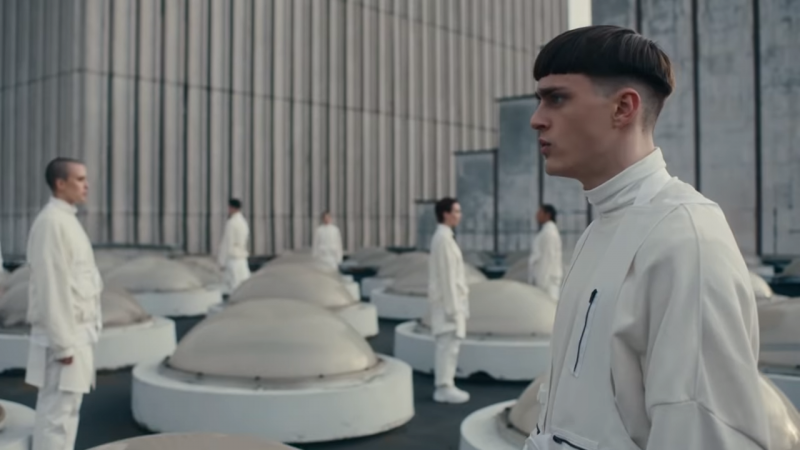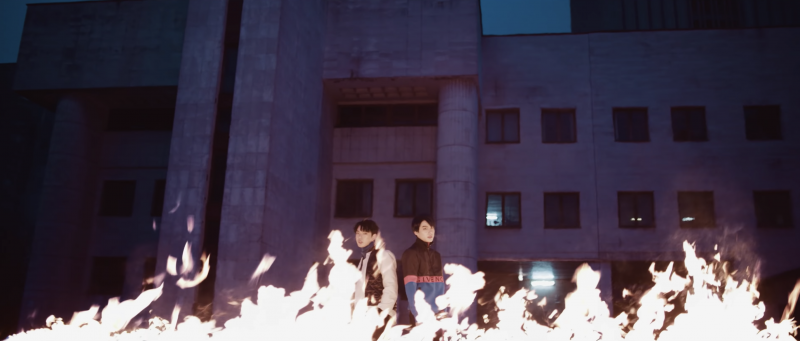
This Kyiv’s Library Plays the Role of a Dystopian Headquarters in Every Western Music Video
March 6, 2020
By Annyris Oms and Olena Lysenko
In recent years, the Ukrainian capital, Kyiv became a hot destination for video production. The city has served as a location for a variety of foreign music videos, to name a few, from iconic Time Impala and beloved by many Avicii, to soul soothing Hurts, who shoot not one, but two music videos here. Kyiv attracts creative minds with its rich architecture and impressive locations. The bridges in Kyiv made the perfect background for many brands’ campaigns, such as Diesel “Go with the Flaw” and Mazda “Prepare to Be Amazed”, which were shot at the unfinished Podilsko-Voskresensky Bridge; the Apple Watch campaign ad was shot at Kyiv-Pasazhyrskyi Railway Station.
But there’s this one building, which is often perceived by Western music video directors as something that has an “authoritarian vibe”. Every time they need to conjure up a dystopian vision of the future, they chose the Vernadsky National Library of Ukraine.
Vernadsky National Library is the largest library in Ukraine by number of items catalogued: it holds a large collection of Old Church Slavonic manuscripts, produced in 10th century and Peresopnytsia Gospel, a 16th-century manuscript traditionally used for presidential inaugurations. On August 15, 1918 Hetman of Ukraine Pavlo Skoropadskyi signed Act on the Creation of the National Library of Ukrainian State. It has changed its official name several times, outlasted the turbulent world war period, and one significant arson in May 1964, and has managed to keep the collection untouched, on account of the dedication and devotion of library staff and scholars.
The modern library building was constructed by the architects Vadym Gopkalo, Vadym Grechina, and Valeryi Peskovsky, in the period of 1975-1989. It represents a combination of neoclassicism and Soviet modernism styles that have functionality, originality, and innovation of Ukrainian architecture of the last third of twentieth century and the beginning of twenty first century. Reading halls and other functional rooms are placed on the first floor, while 27th store building serves as an archive for thousands of works and collections.

Many artists take their creative inspiration from this monumental building and its sophisticated interior design, that encourages creative endeavour to open and flourish. One of the first things you notice as you enter the foyer of the library building is the monumental fresco “Earth’s Pain” created with encaustic painting technique, also known as hot wax painting, by V. Pasyvenko and V. Pryadka. The composition explores the main duty of science – saving life on Earth. Another location that can be seen in a variety of music videos is one of the reading halls with functional design and abundance of natural light.

“Either it’s an advertisement or a music video, there is a variety of mediums for artists to create something new. The most important thing for the Library is to work, benefit, and attract and encourage others to work”, notes Tetiana Koval, Deputy Director for Academic Affairs, who told her perspective on the library’s popularity among the creators and artists. She knows almost every artist who visited the library, because there are not even a chance for unauthorized people to enter the library, but as soon as you are recognized you are more than welcome to become a part of this unique world inside of the library.
Tetiana has been working at Vernadsky National Library for 44 years, since September 16, 1976, and came a long way from being a librarian to deputy director for academic affairs. Tetiana is a fan and advocate of her work and library without exaggeration. “This is a monumental masterpiece. Walking here, among the sculptures and interiors, in the library, I am feeling excited”, says Tetiana. She underlines the originality of the ramp that connects second and third floor, while many visitors may notice the portrait sculptures of the most prominent scholars right away: Yaroslav Mydryi, Ivan Fedorov, Mychailo Lomonosov, Hryhory Skovoroda, Mykola Lobachevsky, Alexander Pushkin, Taras Shevchenko, Dmytro Mendeleev, Ilya Mechnikov, Konstantyn Tsyalkovsky, and Oleksandr Popov. The library management is more than flattered by the attention the building gains, as it is deserved and mutual process, where the creative team has beautiful location for their idea and the building remains in its well-deserved spotlight.



Earth’s Pain, a fresco painting by V. Pasyvenko and V. Pryadka. Credit: Screenshot of Paolo Nutini’s music video for “Iron Sky”
The first music video worth mentioning is Paolo Nutini – Iron Sky, released on August 7, 2014, which includes the beautiful mural that greets the visitors when they enter Vernadsky Library. The moment we see the familiar interiors, the song becomes accompanied by the sample of Charlie Chaplin’s monologue from The Great Dictator. It is quite alluring juxtaposing of the Nutini track mixed with the extract of Chaplin’s first movie with dialog, which criticizes the power greediness with the mural fresco that shows the science (and therefore individual) selfless duty to prevent one’s corruption for the sake of humanity’s wellbeing.



Reading room and the ramp that connects second and third floor. Credit: Screenshot of Paloma Faith’s music video for “Crybaby”
At the same time, Paloma Faith – Crybaby, released on September 21, 2017, was probably the first band to implement the dystopian narrative in their music video. We are introduced to the group of youth who are instructed by elder man emphasizing that “emotion, empathy, feeling. These human qualities, gentlemen, are for the weak, for those that we leave behind, for those that we remove from the crop. You are the leaders of tomorrow, breed to be the future’s history”. The interior of the library is presented as the facility where these leaders of tomorrow are taught, where they stay in line. Of course, the conflict of order and individual freedom is evident for the audience.



Rooftop and reading room. Credit: Screenshot of R3HAB & ZAYN & Jungleboi’s music video for “Flames”
The most recent music video produced at Vernadsky Library, R3HAB & ZAYN & Jungleboi – Flames, released on January 30, 2020, also utilizes similar themes and patterns where the space of stairs and reading halls are not simply the background but the extension of the collective synchronized dance. Followed by a rebel, the order is disrupted, showing that different times are yet to come. Still, we wonder, is it possible to create a brighter future without acknowledging the past?



Catalogue room. Credit: Screenshot of Netta’s music video for “Bassa Sababa”
In its turn, Netta’s music video for Bassa Sababa released on January 31, 2019 narrates a more personal story of the singer. It begins with a pink rhino in the familiar to us reading hall, with a 8bit start menu screen, then it cuts to a Netta ready to get married but her fiance escapes the ceremony. Right away the man runs through the archive room with the stacks and catalogs just for a few seconds of the action. Notably, the same archive section was seen in the HBO “Chernobyl” series, when the character of Uliana Chomyk searched for the plant documents. We follow back and forth from the dance in the hall to a chase that is presented as a game.



Entrance hall and winter garden. Credit: Screenshot of NCT U 엔시티 유 music video for “Boss”
Another prominent example of clever use of the modernist architecture is NTC U – Boss, released on February 18, 2018. The video combines the distinctive and elaborated choreography with stunning set (the main hall of the library and other elements of the building). The video also includes famous futuristic bus station (now abandoned), Ukrainian House, and one of the Kyiv residential areas.
Vernadsky National Library Of Ukraine
3, Holosiivskyi Avenue
Demiivska metro station

